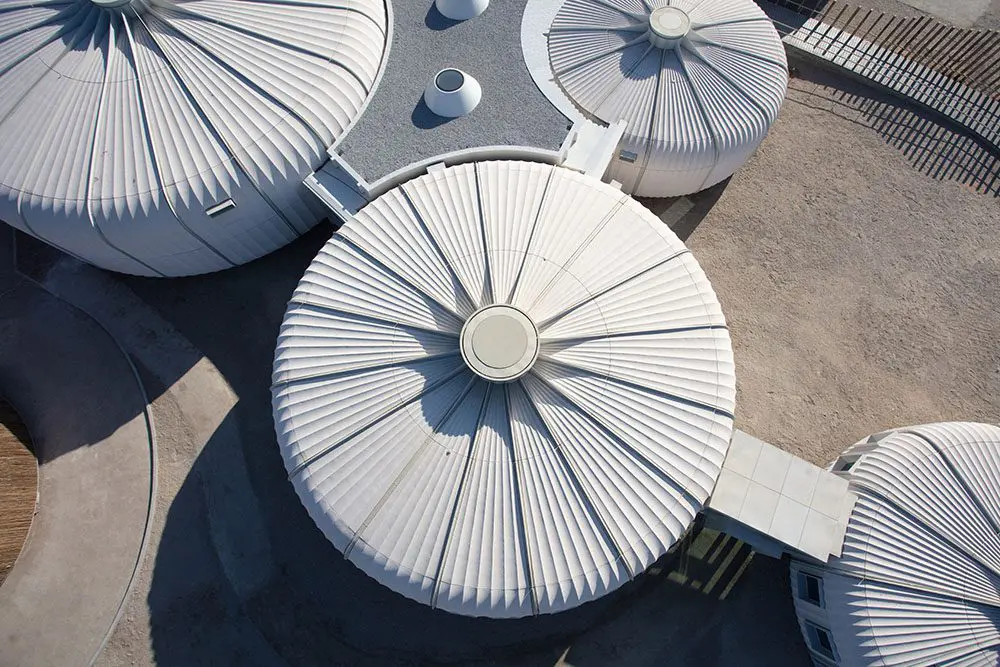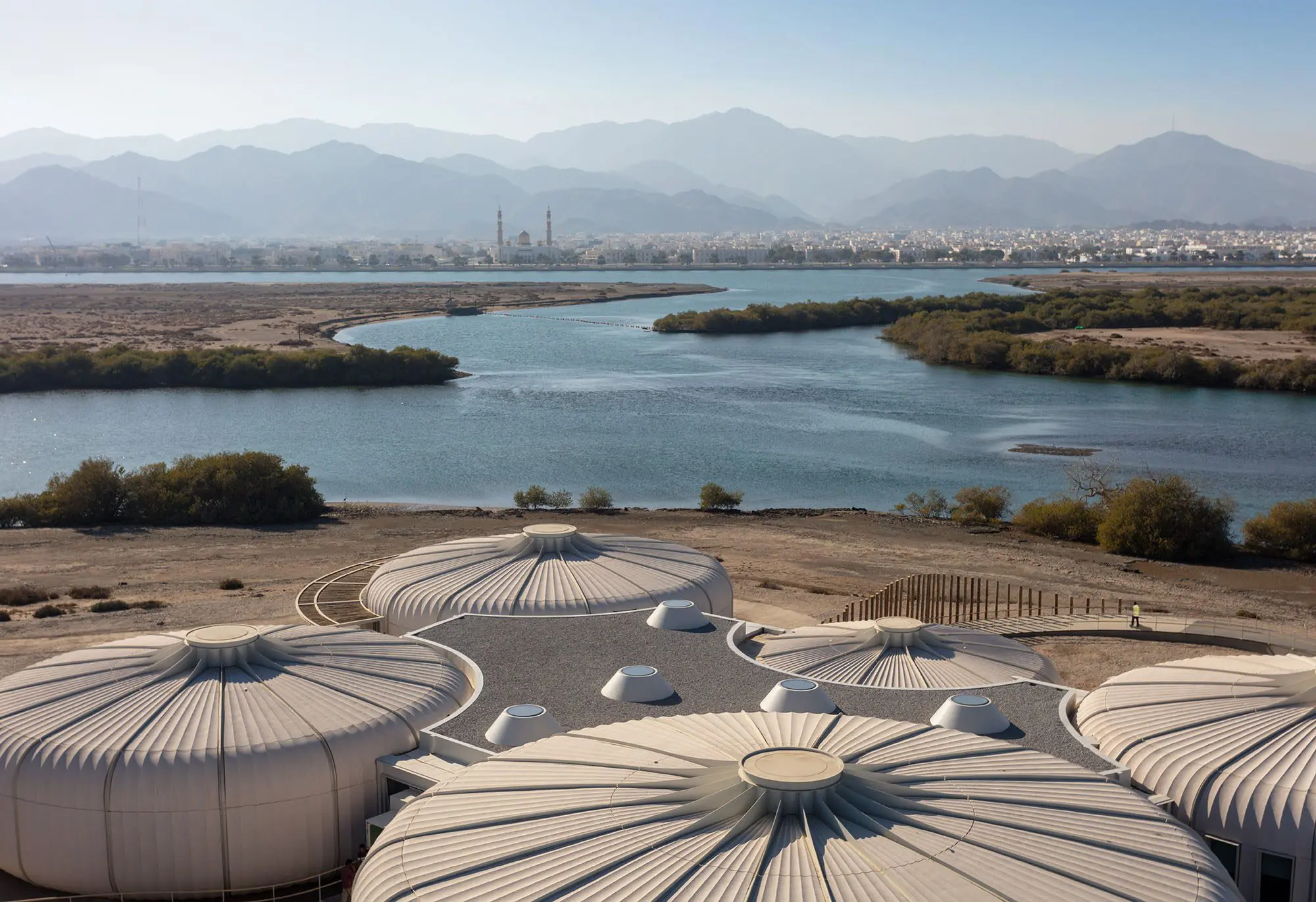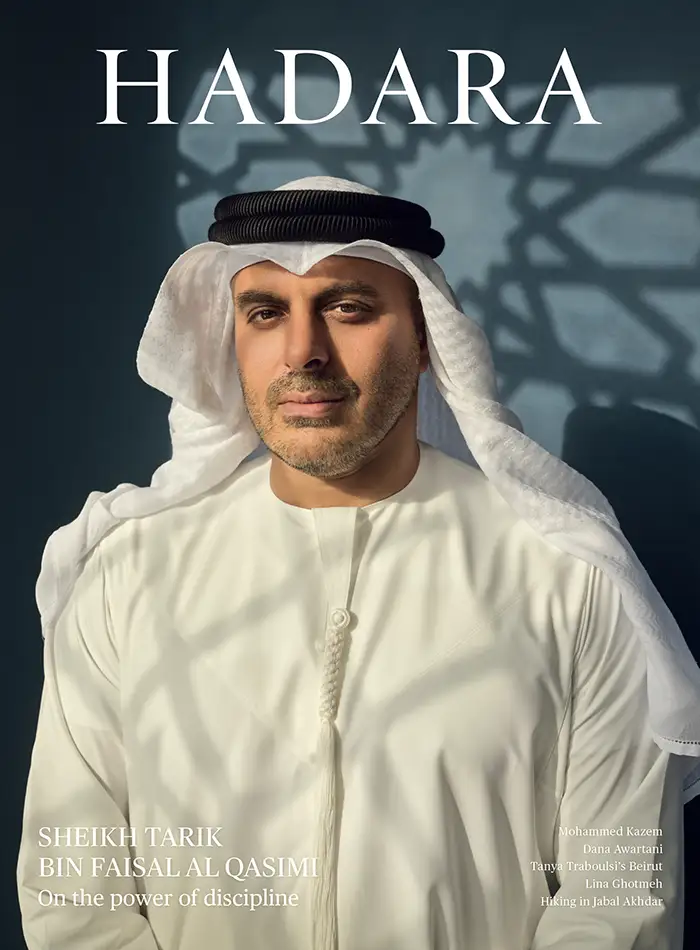A gift of life
The Khor Kalba Mangrove Centre on Sharjah’s east coast gleams amid its revitalised but still sensitive ecosystem.
By Catherine Mazy
Photographs by Mark Goodwin
A decade ago, His Highness Sheikh Dr. Sultan Bin Mohamed Al Qasimi, the Ruler of Sharjah, created an expansive conservation area on the emirate’s east coast, stretching from the nearby mountain ridge, across the coastal plain and for several kilometres out to sea. At the foot of the Hajar Mountains, Al Hefaiyah Mountain Conservation Centre shelters 30 species, notably the endangered Arabian leopard. It’s joined by Khor Kalba Mangrove Centre to protect and rejuvenate the area around one of the region’s oldest and most northerly mangrove forests.
If the centre looks familiar, that’s because it’s based on the same concept as the buildings in Buhais Geology Park. Both are inspired by sea urchins and designed by London-based Hopkins Architects for Sharjah’s Environment and Protected Areas Authority (EPAA). And both provided design that involved minimal excavation in environmentally sensitive sites. But they’re more like cousins than twins, with some important differences.
“Al Hefaiyah and Khor Kalba together make a huge protected area,” says Mariam Alkaabi, previously head of research and environmental studies for the EPAA and now administrator in charge of the nearby Kalba Birds of Prey Centre. “About 500 hectares of mangrove are protected. Mangroves have local and global significance for wildlife, for carbon storage and for coastal stabilisation.”
Mangroves are unusual-looking shrubs or trees that have adapted to grow in coastal salty water. They use pneumatophores, or spiky roots that grow upward like snorkels, to deliver oxygen to the main roots while the tide is in. This web of roots protects shorelines from erosion and forms an important, complex ecosystem. The Khor Kalba mangroves are one of the few nesting places for a rare subspecies of white collared kingfisher, Todiramphus chloris kalbaensis, which was severely threatened but, under protection, has now grown to some 64 breeding pairs. The water attracts diverse sea life, including sting rays. Neighbouring beaches are nesting places for green, olive ridley and endangered hawksbill turtles.
Hopkins designed a visitor centre as well as facilities for rescuing turtles, birds and other wildlife. As with Buhais, the Khor Kalba centre was configured for the smallest possible impact on the environment, from construction to operation, says Simon Fraser, the architect at Hopkins leading both projects.
To blend into the flat coastal landscape, Fraser first considered a low, partly buried building, with sand on top. But he soon changed his mind. “I felt on this site it wasn’t appropriate to start digging into pristine landscape,” he says. To protect the environment, “I wanted to come up with something that could be prefabricated and positioned on the site. Also, every 10 years or so, the sea floods over the whole site. So if we had built into the sand, that probably wouldn’t have been a good idea.”
Before being designated a protected area, the site was a popular picnic spot. “There was quite a lot of rubbish coming into the water,” Fraser says. However, in the four or five years between being closed to the public and the start of construction, wildlife returned and flourished. The picnic ground remained the most disturbed spot, and so it was the logical place to site the buildings.
A natural feel was paramount for Sharjah’s planners. “We want people to experience nature rather than architecture,” says Peter Jackson, architect adviser in His Highness the Ruler’s Office. “The architecture needs to be very respectful of the environment, and here, it is.”
The centre consists of five connected pods plus two others in the rounded, ribbed form of the sea urchin, with an oculus in each centre. In fact, they also resemble rounded fishing baskets, like those found at a fish processing area near the city of Kalba, Fraser notes. The pods sit on foundation disks, which required minimal digging, and are grouped for aesthetics, with flexibility for potential expansion by adding pods later.

The centre consists of five connected pods plus two others in the rounded, ribbed form of a sea urchin.
The structures blend into the flat coastal landscape, ensuring visitors experience nature, not architecture.
The fishing-basket analogy became starker during construction, as the pods’ skeletons were assembled. Such a transparent design might have been beautiful, Fraser says, but not practical in the region’s heat. Instead, the spaces between the ribs were filled in with precast white concrete pieces, each scalloped or ribbed on the outside like clamshells, for textural interest. In Buhais, these sections are covered with steel in a reddish finish that blends with the surrounding desert. In Kalba, the salty environment would have been too corrosive for metal. Instead, the concrete sections are as pristine as bleached sea urchin shells—the white comes from Omani marble mixed in as aggregate.
“They both really fit their environment,” Jackson says, adding that the coastal setting is as challenging as they come, combining high heat and humidity as well as an aggressive salty atmosphere.
The site couldn’t be bulldozed either. Layers of the geology, including bands of shells, are visible on a bank near the Kalba centre. “The work has to be done delicately,” Fraser says.
The entire area is delicate. The beach close to the centre is a nesting ground for turtles. The planners allowed for plenty of space, and there are no lights at night that might disturb them. A floating boom protects the tidal creek from oil slicks that emanate from tankers cleaning their tanks offshore. “It’s illegal, and the government forbids this, but it still happens,” endangering not only turtles but also marine and bird life, Jackson says.
The pods include facilities for care of various animals, including surgery on injured turtles. Scientists are conducting research on coastal birds, sea snakes and turtles, Alkaabi says. They also do necropsies on dead animals to determine the cause of death. Turtles can recuperate in a shaded pool outside. Farther back, an aviary gives visitors a look at some of the region’s bird population.
Protection included the surrounding landscape, to attract more diversity of birds, animals and insects, Alkaabi says. Some species came back to the rejuvenated area on their own while others, like the sand gazelle, or reem, were reintroduced.
To let visitors immerse themselves in the mangroves, a timber boardwalk was added that feels natural, threaded discreetly between the branches, inspired by one Jackson discovered in mangroves in Zanzibar. The boardwalk was constructed on timber poles in such a way that only three or four branches needed to be cut and no mangroves were removed, he says. Three bird hides allow visitors to spy on the diverse avian life. Visitors can peer over the side of the bridge across the vast tidal creek to see the vibrant ecosystem of fish and crabs. “It is a rich fish breeding ground. I’ve seen shoals of juvenile barracuda,” Jackson says.
Inside the visitor centre, aquariums are populated with native species. “The display in the tanks mimics the natural environment, so you can see what’s under the surface,” Alkaabi says. From the centre to the boardwalk, the design immerses visitors in the natural environment without disturbing it.
Alkaabi appreciates that the centre’s design looks like sea urchins. “It’s inspired by something that’s already here,” she says. “It’s like they’re living here.”




